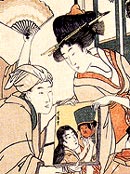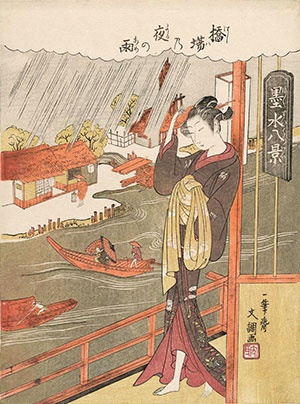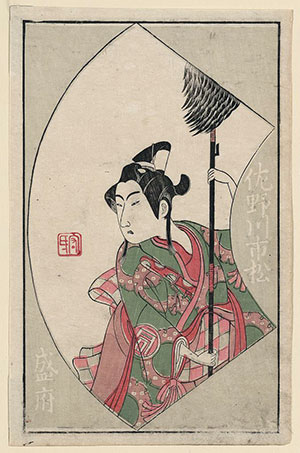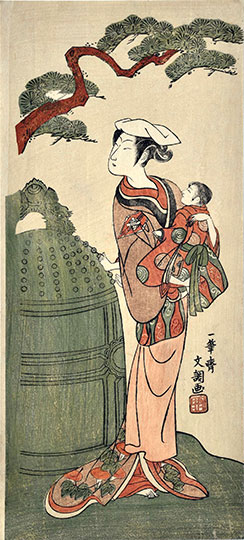

Ippitsusai Bunchô (一筆齋文調)
|
 Ippitsusai Bunchô's (一筆齋文調 act. c. 1755-1790) life, like that of so many other ukiyo-e artists, is shrouded in mystery. We do not know his date of birth, but his birth surname was Mori. The year of his death may be estimated from an undated commemorative surimono designed by Kubo Shunman (1757-1820) and published circa late 1790s, who stated that Bunchô had died seven years earlier. This would suggest his death occurred in the early 1790s, likely 1791 or 1792.
Ippitsusai Bunchô's (一筆齋文調 act. c. 1755-1790) life, like that of so many other ukiyo-e artists, is shrouded in mystery. We do not know his date of birth, but his birth surname was Mori. The year of his death may be estimated from an undated commemorative surimono designed by Kubo Shunman (1757-1820) and published circa late 1790s, who stated that Bunchô had died seven years earlier. This would suggest his death occurred in the early 1790s, likely 1791 or 1792.
Bunchô might have studied with a minor Kanô school artist named Ishikawa Yukimoto [Kôgen]. Just as many artists, actors, writers, poets and townsmen had done, he was engaged in versifying, in his case as a member of a haiku (17-syllable "light verse": 俳句) poetry circle named the "Edo-za" through which he became a practitioner of haikai poetry (linked verses of 31 syllables: 俳諧). He also wrote senryû (川柳), a satirical poem-form named after its creator, Karai Senryû (1718-1790) that was generally written in haiku form.
We do know that Bunchô provided illustrations for a woodblock-printed book of fiction as early as 1755, and there is a surviving egoyomi (picture calendar: 絵暦) from 1790, but nearly every surviving work can be dated to a much shorter period between 1766 and 1773. Bunchô was a print designer and painter of unique sensibilities, working for a brief time in the shadow of Suzuki Harunobu, but generally avoiding mere derivations of that master's style.
Among the various series of chûban-format bijinga (pictures of beautiful women: 美人画) by Bunchô is a fine work (see image above) that displays some influence from Harunobu. It is titled Hashiba no yoru no ame (Night rain at Hashiba: 橋場の夜の雨) from the series Bokusui hakkei (Eight views of inky water: 墨水八景) circa late 1770s. The pun on hakkei (Eight views: 八景) alludes to a popular theme for serialized ukiyo-e prints and paintings, often used in connection with mitate (analog: 見立) topics. In Japan, the traditional views were called Eight Views of Omi, but the idea goes back farther to China and the Eight Views of the Xiao and Xiang Rivers. Nevertheless, the conceit here in Bunchô's design is to associate with gentle humor the everyday activities of Edo's floating world with the classical subject of "Eight views." Moreover, the reference to "inky water" in the print title is a pun referring to the Sumdia River, visible here though faded from blue to a dark brownish-green. The lithe young beauty has that distinctive "Bunchô look," particularly in the face, which separates his work from his contemporaries, despite whatever influences might be found in his bijinga.
 Various scholars have identified what might be called an "astringent" quality in Bunchô's drawing. His portraits of women or onnagata (male kabuki actors in female roles) are usually distinguishable from similar works by Harunobu or Katsukawa Shunshô. His designs have a less lyrical quality than do Harunobu's, and a sharper, somewhat more "pinched" aspect compared to Shunshô's. The women in Bunchô's prints have faces that are narrow and angular, with longer noses and small, slanted eyes. His portraits of actors in male roles are, in general, less animated and less aggressive than Shunshô's. Overall, Bunchô's style may appear a bit austere and remote. Nevertheless, those who appreciate Bunchô's work rate him as one of the most accomplished masters of the ukiyo-e school.
Various scholars have identified what might be called an "astringent" quality in Bunchô's drawing. His portraits of women or onnagata (male kabuki actors in female roles) are usually distinguishable from similar works by Harunobu or Katsukawa Shunshô. His designs have a less lyrical quality than do Harunobu's, and a sharper, somewhat more "pinched" aspect compared to Shunshô's. The women in Bunchô's prints have faces that are narrow and angular, with longer noses and small, slanted eyes. His portraits of actors in male roles are, in general, less animated and less aggressive than Shunshô's. Overall, Bunchô's style may appear a bit austere and remote. Nevertheless, those who appreciate Bunchô's work rate him as one of the most accomplished masters of the ukiyo-e school.
Bunchô collaborated with other artists during his career, including Harunobu, Isoda Koryûsai, and Katsukawa Shunshô. With the latter he produced one of the most important woodblock-printed books in the history of ukiyo-e, the Ehon butai ôgi (Picture book of stage fans: 絵本舞台扇) carved by Endo Matsugorô and published in three volumes by Kariganeya Ihei in 1770. With this book Shunshô and Bunchô demonstrated their seminal and widely influential style of nigao ("likenesses": 似顔) for actor portraiture.
One sheet designed by Bunchô in volume 1 is shown on the left, signed with a seal based on his family name, which reads Mori uji (Mori family). The actor is identified in two places, at the middle rght by his stage name Sanogawa Ichimatsu II (佐野川市松), and by his poetry pseudonym Seifu (盛府) at the lower left. The role is unidentified. Sanogawa II (1747-1785), who died before reaching 40 years of age, specialized in performing as waka onnagata (young females: 若女方), wakashu (young males: 若衆), and iro aku (young villains: 色悪), as well as jitsugotoshi (righteous male characters: 實事師).
 Bunchô designed numerous prints in the hosoban format. The print at the lower right, published by Nishimura Yohachi (Eijudô), portrays the actor Nakamura Matsue I (中村松江) as Sakuragi, wife of Goi no Shô Munesada, in the historical drama Kuni no Hana Ono no Itsumoji (Flower of Japan: Ono no Komachi's five characters: 倭花小野五文字) at the Nakamura Theater, Edo in 11/1771. The play is based on legendary episodes in the life of famous female poet Ono no Komachi ((小野 or 小町, c. 825 – c. 900), one of the six immortral poets (Rokassen: 六歌仙). The theatrical Munesada is a stand-in for the historical Yoshimine no Munesada (良岑宗貞), better known as Henjô (遍昭 or 遍照, 816-890), a Japanese waka (和歌) poet (also one of the Rokassen) and Buddhist priest. He was rumored to have had a love affair with Komachi, but this might be nothing more than a later literary fantasy. The title of the play suggests a pun on "five characters," theatrical roles that allude to the remaining five Rokkasen poets other than Komachi.
Bunchô designed numerous prints in the hosoban format. The print at the lower right, published by Nishimura Yohachi (Eijudô), portrays the actor Nakamura Matsue I (中村松江) as Sakuragi, wife of Goi no Shô Munesada, in the historical drama Kuni no Hana Ono no Itsumoji (Flower of Japan: Ono no Komachi's five characters: 倭花小野五文字) at the Nakamura Theater, Edo in 11/1771. The play is based on legendary episodes in the life of famous female poet Ono no Komachi ((小野 or 小町, c. 825 – c. 900), one of the six immortral poets (Rokassen: 六歌仙). The theatrical Munesada is a stand-in for the historical Yoshimine no Munesada (良岑宗貞), better known as Henjô (遍昭 or 遍照, 816-890), a Japanese waka (和歌) poet (also one of the Rokassen) and Buddhist priest. He was rumored to have had a love affair with Komachi, but this might be nothing more than a later literary fantasy. The title of the play suggests a pun on "five characters," theatrical roles that allude to the remaining five Rokkasen poets other than Komachi.
Bunchô has been (and should be) considered as having a place among the finest ukiyo-e print artists. Yet his oeuvre seems, at least in the West, to puzzle those who consider him without investing much effort into the act of evaluation. Early collectors and commentators struggled to describe his style. Ficke wrote that Bunchô's work was "lifted by his originalty to a place quite apart from [Shunshô] ... with a charm different from that of any other ukiyo-e artist," yet also declared that he found in Bunchô "an intangible spiritual abnormailty." Michener thought Bunchô's style was angular and harsh ... and rarely completely satyisfying," and yet believed that "the superior quality of his work is instinctively felt." Lane had an easier time of it, mentioning Bunchô's "nervous, haunting brilliance" and concluding that his work "combined the lyricism of Harunobu with the realism of Shunshô to produce some of the most uniquely individual prints in ukiyo-e." Perhaps Lane understood Bunchô best, in the Japanese manner, expressed by the term shibui (渋い), which Lane understood as "astringent, not cloying, unfathomable."
© 2001-2019 by John Fiorillo
BIBLIOGRAPHY
- Clark, T. and Ueda, O: The Actor's Image: Print Makers of the Katsukawa School. Art Institute of Chicago, 1994, pp. 82-83, and 487.
- Ficke, A.D.: Chats on Japanese Prints. London: T. Fisher Unwin, Ltd, 1915, , pp. 185, 186, 189.
- Michener, J.: Japanese Prints: From the Early Masters to the Moderns. Rutland: Tuttle, 1959, p. 110.
- Lane, R.: Masters of the Japanese Print: Their World and Their Work. New York: Doubleday, 1962, pp. 172 and 177
- Riccar Art Museum (Eds.): Exhibition of Ukiyo-e by Ippitsusai Bunchô. Tokyo 1978.
- Tsubouchi Memorial Theatre Museum (Eds.): Ippitsusai Bunchô. Tokyo: Waseda University, 1991.
Viewing Japanese Prints |